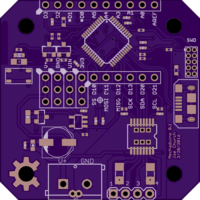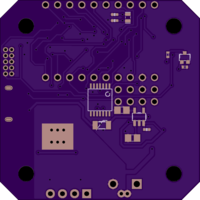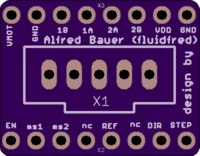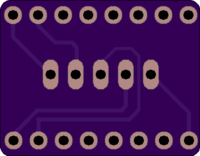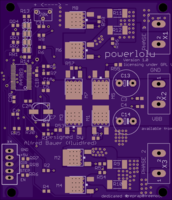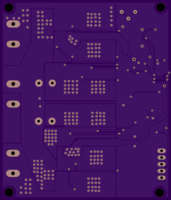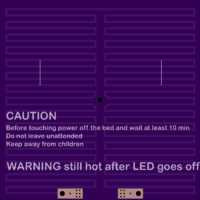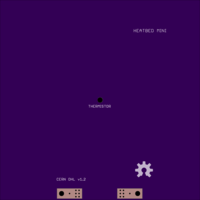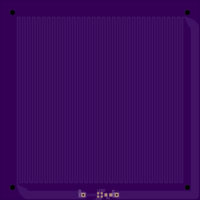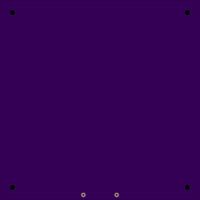Shared Projects by WarHawk-AVG
Shared Projects by WarHawk-AVG
Mechaduino01
2 layer board of 1.65 x 1.65 inches (41.9 x 41.9 mm)
Uploaded:
February 23, 2017
Shared:
February 23, 2017
Total Price:
$13.60
2 layer board of 1.65x1.65 inches (41.94x41.94mm). $13.60 for three.
[Logo image](https://gith…
2 layer board of 1.65x1.65 inches (41.94x41.94mm). $13.60 for three.
Engineers use servo motors to achieve the precision motion required in applications such as robotics, automation, and CNC manufacturing. Like RC servos, industrial servos actively correct for external disturbances. Unlike RC servos, industrial servos can provide very accurate motion, and often support advanced motion control modes. Unfortunately the cost of industrial servos is prohibitive to the individual maker (thousands of dollars per motor).
We’ve been developing an affordable open-source industrial servo motor, opening the door to sophisticated mechatronics applications. Our design leverages the low cost of mass produced stepper motors. We are able to achieve very high resolution via 14b encoder feedback (after calibration routine!).

Project Goals
Position, velocity, torque loops
Step & direction inputs for drop-in compatibility with stepper motors / step stick
I2c, serial inputs
Customizable/open source with access to internal variables
Transparent and user-definable control algorithms (commercial servos often lack this)
Arduino compatible with easy to use interface
High resolution pointing (sub 0.1 degree)
Low cost (should not be a huge leap from stepper + stepstick cost)
Serial interfaces for inter-motor communication
On-board processor allows for stand alone for simple applications
Adjustable commutation profiles
PID auto tuning
Anti-cogging capable
Open to customization. Outside of our firmware, we see Mechaduino as a very useful hardware package. If you would like to use the stepper motor in open loop mode w/ encoder to verify location, you can do that.
Strategy
An industrial servo motor can be broken down into four main components (below). First we looked at each of these components and tried to piece together an affordable breadboard-level prototype. After some experimentation, we were able to distill out a working lineup of components. From there, we’ve been iterating on our design, working out all the kinks, and tuning the control loops. It’s starting to come together!
…Back to those four main components:
The actual motor, usually of the brushless dc variety. When you look at industrial servo motors, a big chunk of the cost is the motor itself. They are often custom built, or at least built in limited quantities, which means $$$. Watt for watt, I'd guess that a mass produced NEMA 17 or NEMA 23 stepper motor is between a tenth and a hundredth the cost of the BDC motors used in industrial servos. Although their design is optimized for "stepping," stepper motors are really just 50-pole brushless dc motors. They can be controlled exactly like a more traditional 3 phase BDC motor with more poles. So that's the plan. It's working!
A sensor for feedback, usually an encoder. Optical encoders are pretty standard, but get quite pricey if you want high resolution and/or absolute position information. We were intrigued by some of the cheap, high resolution magnetic encoders offered by vendors like AMS. It turns out that although they claim 12 and 14 bit resolutions (that's 0.09 and 0.02 degrees respectively), they suffer from non-linearities on the order of a degree or so! However, we found that this non-linearity is very repeatable, and we were able to develop a quick, self contained (on motor) calibration routine that restores resolution to better than 0.1 degrees. (More on this later. This was a significant design effort and is worthy of its own build log!)
Drive circuitry/power electronics to excite the motor windings. Many industrial servos use discrete H bridges. Each phase requires it's own H bridge ( for a two phase motor... half bridges for each in a three phase motor), which consists of at least 4 if not 8 (...including freewheeling diodes) discrete switching devices. Throw in gate drive circuitry, and things start to get expensive. We hoped to find a single-chip, integrated solution that would allow for current feedback, and we found just that in the A4954 dual full bridge PWM driver.
Control Electronics. Usually a microcontroller or FPGA. Early on, we decided that Arduino compatibility was a must in order to make the firmware as accessible as possible. We chose to use a SAMD21 ARM M0+ (Arduino Zero compatible) processor to balance cost and performance. Our breadboard prototype system verified that this processor was more than capable of executing the necessary algorithms.
Application Examples:
Fine, closed loop positioning for 3D printers
Fine pointing for optics (laser, telescope, camera gimbal)
Velocity loop for a record player
Force feedback/impedance control for robotics
Force feedback for gaming controllers
Adjustable mechanical impedance: virtual spring,mass,damper
Electrical gearing between two axes on a cnc machine, etc.
Haptics
Tele-operation
Gravity-cancellation (counter the gravitational torques on a robotic arm for example)
Load detection and characterization (simple case: use as a scale!)
Paper towel/tp dispenser
Variable load (brake)
Variable load (generator)
After market valve control (automate a garden hose, etc)
Other Advantages:
Finer resolution than stepper motors (0.02 degrees)
True closed loop for disturbance rejection
Lower power consumption: only uses power to fight disturbances. This in turn means higher peak torque.
Absolute position control (not incremental). No need to home on power-on.
License
All Mechaduino related materials are released under the Creative Commons Attribution Share-Alike 4.0 License
I had some difficulty getting some of the aesthetics on the board, namely the silk of tropical labs and the Mechaduino in copper on the top layer…everything else is 100% as is from his github
Show full description
2 layer board of 1.65x1.65 inches (41.94x41.94mm). $13.60 for three.
[Logo image](https://gith…
2 layer board of 1.65x1.65 inches (41.94x41.94mm). $13.60 for three.
Engineers use servo motors to achieve the precision motion required in applications such as robotics, automation, and CNC manufacturing. Like RC servos, industrial servos actively correct for external disturbances. Unlike RC servos, industrial servos can provide very accurate motion, and often support advanced motion control modes. Unfortunately the cost of industrial servos is prohibitive to the individual maker (thousands of dollars per motor).
We’ve been developing an affordable open-source industrial servo motor, opening the door to sophisticated mechatronics applications. Our design leverages the low cost of mass produced stepper motors. We are able to achieve very high resolution via 14b encoder feedback (after calibration routine!).

Project Goals
Position, velocity, torque loops
Step & direction inputs for drop-in compatibility with stepper motors / step stick
I2c, serial inputs
Customizable/open source with access to internal variables
Transparent and user-definable control algorithms (commercial servos often lack this)
Arduino compatible with easy to use interface
High resolution pointing (sub 0.1 degree)
Low cost (should not be a huge leap from stepper + stepstick cost)
Serial interfaces for inter-motor communication
On-board processor allows for stand alone for simple applications
Adjustable commutation profiles
PID auto tuning
Anti-cogging capable
Open to customization. Outside of our firmware, we see Mechaduino as a very useful hardware package. If you would like to use the stepper motor in open loop mode w/ encoder to verify location, you can do that.
Strategy
An industrial servo motor can be broken down into four main components (below). First we looked at each of these components and tried to piece together an affordable breadboard-level prototype. After some experimentation, we were able to distill out a working lineup of components. From there, we’ve been iterating on our design, working out all the kinks, and tuning the control loops. It’s starting to come together!
…Back to those four main components:
The actual motor, usually of the brushless dc variety. When you look at industrial servo motors, a big chunk of the cost is the motor itself. They are often custom built, or at least built in limited quantities, which means $$$. Watt for watt, I'd guess that a mass produced NEMA 17 or NEMA 23 stepper motor is between a tenth and a hundredth the cost of the BDC motors used in industrial servos. Although their design is optimized for "stepping," stepper motors are really just 50-pole brushless dc motors. They can be controlled exactly like a more traditional 3 phase BDC motor with more poles. So that's the plan. It's working!
A sensor for feedback, usually an encoder. Optical encoders are pretty standard, but get quite pricey if you want high resolution and/or absolute position information. We were intrigued by some of the cheap, high resolution magnetic encoders offered by vendors like AMS. It turns out that although they claim 12 and 14 bit resolutions (that's 0.09 and 0.02 degrees respectively), they suffer from non-linearities on the order of a degree or so! However, we found that this non-linearity is very repeatable, and we were able to develop a quick, self contained (on motor) calibration routine that restores resolution to better than 0.1 degrees. (More on this later. This was a significant design effort and is worthy of its own build log!)
Drive circuitry/power electronics to excite the motor windings. Many industrial servos use discrete H bridges. Each phase requires it's own H bridge ( for a two phase motor... half bridges for each in a three phase motor), which consists of at least 4 if not 8 (...including freewheeling diodes) discrete switching devices. Throw in gate drive circuitry, and things start to get expensive. We hoped to find a single-chip, integrated solution that would allow for current feedback, and we found just that in the A4954 dual full bridge PWM driver.
Control Electronics. Usually a microcontroller or FPGA. Early on, we decided that Arduino compatibility was a must in order to make the firmware as accessible as possible. We chose to use a SAMD21 ARM M0+ (Arduino Zero compatible) processor to balance cost and performance. Our breadboard prototype system verified that this processor was more than capable of executing the necessary algorithms.
Application Examples:
Fine, closed loop positioning for 3D printers
Fine pointing for optics (laser, telescope, camera gimbal)
Velocity loop for a record player
Force feedback/impedance control for robotics
Force feedback for gaming controllers
Adjustable mechanical impedance: virtual spring,mass,damper
Electrical gearing between two axes on a cnc machine, etc.
Haptics
Tele-operation
Gravity-cancellation (counter the gravitational torques on a robotic arm for example)
Load detection and characterization (simple case: use as a scale!)
Paper towel/tp dispenser
Variable load (brake)
Variable load (generator)
After market valve control (automate a garden hose, etc)
Other Advantages:
Finer resolution than stepper motors (0.02 degrees)
True closed loop for disturbance rejection
Lower power consumption: only uses power to fight disturbances. This in turn means higher peak torque.
Absolute position control (not incremental). No need to home on power-on.
License
All Mechaduino related materials are released under the Creative Commons Attribution Share-Alike 4.0 License
I had some difficulty getting some of the aesthetics on the board, namely the silk of tropical labs and the Mechaduino in copper on the top layer…everything else is 100% as is from his github
Show full description
-
Actions
- Order Board
- Download
- Permalink
- Embed link
Ordering shared project
Hey there! Before ordering, make sure you have all the info you need to complete and use this design. This usually means a component list, and sometimes additional information such as assembly notes, source code, or usage guides.Since this is a project designed by a community member, it may contain design errors that prevent it from working as intended. OSH Park cannot place any guarantees about the functionality or correctness of the design.
Powerlolu Pololu
2 layer board of 0.80 x 0.62 inches (20.2 x 15.8 mm)
Uploaded:
February 21, 2017
Shared:
February 21, 2017
Total Price:
$2.45
Powerlolu Pololu <-link to source
2 layer board of 0.80x0.62 inches (20.22x15.82mm). $2.45 for three.
High Power Pololu Board (Powerlolu) based on A4989 - can be connected to RAMPS Pololu port
Description
Powerlolu can drive stepper motors up…
Powerlolu Pololu <-link to source
2 layer board of 0.80x0.62 inches (20.22x15.82mm). $2.45 for three.
High Power Pololu Board (Powerlolu) based on A4989 - can be connected to RAMPS Pololu port
Description
Powerlolu can drive stepper motors up to 500 Watts, drawing currents up to 10 Amps. The existing Pololu boards found in common RepRap 3D printers are at their limits when driving the 2 Nema17 z-axis stepper motors in parallel.
Continuous z-axis movement can cause the board to overheat. These boards hardly drive stepper motors bigger than a Nema17. To avoid overheating or to drive larger motors a more powerful driver board is needed.
The Powerlolu board enables the use of bigger stepper motors for a wide range of uses. This could be the conversion of manual milling machines into computer controlled milling machines (CNC-Machines) using the affordable electronics such as Arduino and RAMPS. Building 3D printers with a larger print volume or with larger extruders would be possible.
Tested the design by connecting a Nema43 stepper motor by Nanotec Electronic (capable of 6.6 Amps per coil, Torque 2000Ncm, Weight 8,4kg) to a Powerlolu attached to a 3D printer’s RAMPS X-port.
A short video of the new driver can be seen on YouTube at https://www.youtube.com/watch?v=G9FWvhZI7rs .
After two hours of motor usage the Powerlolu board only got luke warm - however see Installation Note
The schematics for the Powerlolu driver are freely available at https://github.com/fluidfred/powerlolu.
Technical specifications:
3-wire control with DIR, STEP, Enable-signal, compatible to the Pololu board
Supply voltage of the stepper motor from 12V to 50V
Adjustable stepping via SMD-jumper, 1, 1/2, 1/4, 1/16 (default) steps
Precision pot to adjust the current limiter
no extra heat sink required due to passive cooling up to NEMA 23 stepper motors.
Molex snap-on connector for connecting the RAMPS board to the Powerlolu
Dimensions PCB: 75.5mm x 65mm
Important installation note:
Observe the heat emission when using stepper motors larger than NEMA 23. If necessary, implement a cooling system, i.e. heat sinks mounted at the power-Mosfets and a fan. Each individual Powerlolu should be protected by connecting an appropriate fuse between VBB (X2) and the power source of the stepper motor.
More installation notes can be found under http://wiki.germanreprap.com/en/handbuch/powerlolu concerning wiring with RAMPS and current limiter adjustment.
Show full description
Powerlolu Pololu <-link to source
2 layer board of 0.80x0.62 inches (20.22x15.82mm). $2.45 for three.
High Power Pololu Board (Powerlolu) based on A4989 - can be connected to RAMPS Pololu port
Description
Powerlolu can drive stepper motors up…
Powerlolu Pololu <-link to source
2 layer board of 0.80x0.62 inches (20.22x15.82mm). $2.45 for three.
High Power Pololu Board (Powerlolu) based on A4989 - can be connected to RAMPS Pololu port
Description
Powerlolu can drive stepper motors up to 500 Watts, drawing currents up to 10 Amps. The existing Pololu boards found in common RepRap 3D printers are at their limits when driving the 2 Nema17 z-axis stepper motors in parallel.
Continuous z-axis movement can cause the board to overheat. These boards hardly drive stepper motors bigger than a Nema17. To avoid overheating or to drive larger motors a more powerful driver board is needed.
The Powerlolu board enables the use of bigger stepper motors for a wide range of uses. This could be the conversion of manual milling machines into computer controlled milling machines (CNC-Machines) using the affordable electronics such as Arduino and RAMPS. Building 3D printers with a larger print volume or with larger extruders would be possible.
Tested the design by connecting a Nema43 stepper motor by Nanotec Electronic (capable of 6.6 Amps per coil, Torque 2000Ncm, Weight 8,4kg) to a Powerlolu attached to a 3D printer’s RAMPS X-port.
A short video of the new driver can be seen on YouTube at https://www.youtube.com/watch?v=G9FWvhZI7rs .
After two hours of motor usage the Powerlolu board only got luke warm - however see Installation Note
The schematics for the Powerlolu driver are freely available at https://github.com/fluidfred/powerlolu.
Technical specifications:
3-wire control with DIR, STEP, Enable-signal, compatible to the Pololu board
Supply voltage of the stepper motor from 12V to 50V
Adjustable stepping via SMD-jumper, 1, 1/2, 1/4, 1/16 (default) steps
Precision pot to adjust the current limiter
no extra heat sink required due to passive cooling up to NEMA 23 stepper motors.
Molex snap-on connector for connecting the RAMPS board to the Powerlolu
Dimensions PCB: 75.5mm x 65mm
Important installation note:
Observe the heat emission when using stepper motors larger than NEMA 23. If necessary, implement a cooling system, i.e. heat sinks mounted at the power-Mosfets and a fan. Each individual Powerlolu should be protected by connecting an appropriate fuse between VBB (X2) and the power source of the stepper motor.
More installation notes can be found under http://wiki.germanreprap.com/en/handbuch/powerlolu concerning wiring with RAMPS and current limiter adjustment.
Show full description
-
Actions
- Order Board
- Download
- Permalink
- Embed link
Ordering shared project
Hey there! Before ordering, make sure you have all the info you need to complete and use this design. This usually means a component list, and sometimes additional information such as assembly notes, source code, or usage guides.Since this is a project designed by a community member, it may contain design errors that prevent it from working as intended. OSH Park cannot place any guarantees about the functionality or correctness of the design.
Powerlolu
2 layer board of 2.55 x 2.97 inches (64.8 x 75.5 mm)
Uploaded:
February 21, 2017
Shared:
February 21, 2017
Total Price:
$37.90
Powerlolu <-link to source
2 layer board of 2.55x2.97 inches (64.77x75.51mm). $37.90 for three
High Power Pololu Board (Powerlolu) based on A4989 - can be connected to RAMPS Pololu port
Description
Powerlolu can drive stepper motors up to …
Powerlolu <-link to source
2 layer board of 2.55x2.97 inches (64.77x75.51mm). $37.90 for three
High Power Pololu Board (Powerlolu) based on A4989 - can be connected to RAMPS Pololu port
Description
Powerlolu can drive stepper motors up to 500 Watts, drawing currents up to 10 Amps. The existing Pololu boards found in common RepRap 3D printers are at their limits when driving the 2 Nema17 z-axis stepper motors in parallel.
Continuous z-axis movement can cause the board to overheat. These boards hardly drive stepper motors bigger than a Nema17. To avoid overheating or to drive larger motors a more powerful driver board is needed.
The Powerlolu board enables the use of bigger stepper motors for a wide range of uses. This could be the conversion of manual milling machines into computer controlled milling machines (CNC-Machines) using the affordable electronics such as Arduino and RAMPS. Building 3D printers with a larger print volume or with larger extruders would be possible.
Tested the design by connecting a Nema43 stepper motor by Nanotec Electronic (capable of 6.6 Amps per coil, Torque 2000Ncm, Weight 8,4kg) to a Powerlolu attached to a 3D printer’s RAMPS X-port.
A short video of the new driver can be seen on YouTube at https://www.youtube.com/watch?v=G9FWvhZI7rs .
After two hours of motor usage the Powerlolu board only got luke warm - however see Installation Note
The schematics for the Powerlolu driver are freely available at https://github.com/fluidfred/powerlolu.
Technical specifications:
3-wire control with DIR, STEP, Enable-signal, compatible to the Pololu board
Supply voltage of the stepper motor from 12V to 50V
Adjustable stepping via SMD-jumper, 1, 1/2, 1/4, 1/16 (default) steps
Precision pot to adjust the current limiter
no extra heat sink required due to passive cooling up to NEMA 23 stepper motors.
Molex snap-on connector for connecting the RAMPS board to the Powerlolu
Dimensions PCB: 75.5mm x 65mm
Important installation note:
Observe the heat emission when using stepper motors larger than NEMA 23. If necessary, implement a cooling system, i.e. heat sinks mounted at the power-Mosfets and a fan. Each individual Powerlolu should be protected by connecting an appropriate fuse between VBB (X2) and the power source of the stepper motor.
More installation notes can be found under http://wiki.germanreprap.com/en/handbuch/powerlolu concerning wiring with RAMPS and current limiter adjustment.
Show full description
Powerlolu <-link to source
2 layer board of 2.55x2.97 inches (64.77x75.51mm). $37.90 for three
High Power Pololu Board (Powerlolu) based on A4989 - can be connected to RAMPS Pololu port
Description
Powerlolu can drive stepper motors up to …
Powerlolu <-link to source
2 layer board of 2.55x2.97 inches (64.77x75.51mm). $37.90 for three
High Power Pololu Board (Powerlolu) based on A4989 - can be connected to RAMPS Pololu port
Description
Powerlolu can drive stepper motors up to 500 Watts, drawing currents up to 10 Amps. The existing Pololu boards found in common RepRap 3D printers are at their limits when driving the 2 Nema17 z-axis stepper motors in parallel.
Continuous z-axis movement can cause the board to overheat. These boards hardly drive stepper motors bigger than a Nema17. To avoid overheating or to drive larger motors a more powerful driver board is needed.
The Powerlolu board enables the use of bigger stepper motors for a wide range of uses. This could be the conversion of manual milling machines into computer controlled milling machines (CNC-Machines) using the affordable electronics such as Arduino and RAMPS. Building 3D printers with a larger print volume or with larger extruders would be possible.
Tested the design by connecting a Nema43 stepper motor by Nanotec Electronic (capable of 6.6 Amps per coil, Torque 2000Ncm, Weight 8,4kg) to a Powerlolu attached to a 3D printer’s RAMPS X-port.
A short video of the new driver can be seen on YouTube at https://www.youtube.com/watch?v=G9FWvhZI7rs .
After two hours of motor usage the Powerlolu board only got luke warm - however see Installation Note
The schematics for the Powerlolu driver are freely available at https://github.com/fluidfred/powerlolu.
Technical specifications:
3-wire control with DIR, STEP, Enable-signal, compatible to the Pololu board
Supply voltage of the stepper motor from 12V to 50V
Adjustable stepping via SMD-jumper, 1, 1/2, 1/4, 1/16 (default) steps
Precision pot to adjust the current limiter
no extra heat sink required due to passive cooling up to NEMA 23 stepper motors.
Molex snap-on connector for connecting the RAMPS board to the Powerlolu
Dimensions PCB: 75.5mm x 65mm
Important installation note:
Observe the heat emission when using stepper motors larger than NEMA 23. If necessary, implement a cooling system, i.e. heat sinks mounted at the power-Mosfets and a fan. Each individual Powerlolu should be protected by connecting an appropriate fuse between VBB (X2) and the power source of the stepper motor.
More installation notes can be found under http://wiki.germanreprap.com/en/handbuch/powerlolu concerning wiring with RAMPS and current limiter adjustment.
Show full description
-
Actions
- Order Board
- Download
- Permalink
- Embed link
Ordering shared project
Hey there! Before ordering, make sure you have all the info you need to complete and use this design. This usually means a component list, and sometimes additional information such as assembly notes, source code, or usage guides.Since this is a project designed by a community member, it may contain design errors that prevent it from working as intended. OSH Park cannot place any guarantees about the functionality or correctness of the design.
Tinyboy/fabrikator mini 80x80mm heatbed
2 layer board of 3.15 x 3.15 inches (80.0 x 80.0 mm)
Uploaded:
February 07, 2017
Shared:
February 07, 2017
Total Price:
$49.60
Tinyboy 80x80mm heatbed
For Tinyboy 80mm x 80mm and Hobbyking fabrikator mini
Detected 2 layer board of 3.15x3.15 inches (80.01x80.01mm). $49.60 for three.
Roughly $16.53 cents a board Got the idea from here heatbed-mini at 100mm x 100m…
Tinyboy 80x80mm heatbed
For Tinyboy 80mm x 80mm and Hobbyking fabrikator mini
Detected 2 layer board of 3.15x3.15 inches (80.01x80.01mm). $49.60 for three.
Roughly $16.53 cents a board Got the idea from here heatbed-mini at 100mm x 100m tested it pulled 69 watts…reduced size it should pull approx 40~ watts (untested of course)
Show full description
Tinyboy 80x80mm heatbed
For Tinyboy 80mm x 80mm and Hobbyking fabrikator mini
Detected 2 layer board of 3.15x3.15 inches (80.01x80.01mm). $49.60 for three.
Roughly $16.53 cents a board Got the idea from here heatbed-mini at 100mm x 100m…
Tinyboy 80x80mm heatbed
For Tinyboy 80mm x 80mm and Hobbyking fabrikator mini
Detected 2 layer board of 3.15x3.15 inches (80.01x80.01mm). $49.60 for three.
Roughly $16.53 cents a board Got the idea from here heatbed-mini at 100mm x 100m tested it pulled 69 watts…reduced size it should pull approx 40~ watts (untested of course)
Show full description
-
Actions
- Order Board
- Download
- Permalink
- Embed link
Ordering shared project
Hey there! Before ordering, make sure you have all the info you need to complete and use this design. This usually means a component list, and sometimes additional information such as assembly notes, source code, or usage guides.Since this is a project designed by a community member, it may contain design errors that prevent it from working as intended. OSH Park cannot place any guarantees about the functionality or correctness of the design.
ToyREP Heatbed
2 layer board of 4.73 x 4.73 inches (120.0 x 120.0 mm)
Uploaded:
February 03, 2017
Shared:
February 03, 2017
Total Price:
$111.60
ToyREP Heatbed PCB heatbed for ToyREP 3D Printer and other small machines.
This thing is published with courtesy of my friend Dan Kolar who designed this PCB heatbed and made the prototype board. It is just…
ToyREP Heatbed PCB heatbed for ToyREP 3D Printer and other small machines.
This thing is published with courtesy of my friend Dan Kolar who designed this PCB heatbed and made the prototype board. It is just published under my account. Please refer to him as the author.
Working area is 100x100mm Mounting holes are 105x105mm apart. Total size of PCB is 120x120mm Copper layer 35um thick
CNC milled prototype depicted is probably a bit weaker due to fabrication process and final sanding. Originally it was supposed to be 36-40W. With etching you may get better results.
Parameters of the milled prototype are:
Resistance of heat bed c. 4.8 OHM Approximately 2.5A at 12V = 30W. Max. achieved temperature 116°C (at room temperature 24.5°C) in 15-20 minutes
Detected 2 layer board of 4.72x4.72 inches (120.02x120.02mm). $111.60 for three.
Show full description
ToyREP Heatbed PCB heatbed for ToyREP 3D Printer and other small machines.
This thing is published with courtesy of my friend Dan Kolar who designed this PCB heatbed and made the prototype board. It is just…
ToyREP Heatbed PCB heatbed for ToyREP 3D Printer and other small machines.
This thing is published with courtesy of my friend Dan Kolar who designed this PCB heatbed and made the prototype board. It is just published under my account. Please refer to him as the author.
Working area is 100x100mm Mounting holes are 105x105mm apart. Total size of PCB is 120x120mm Copper layer 35um thick
CNC milled prototype depicted is probably a bit weaker due to fabrication process and final sanding. Originally it was supposed to be 36-40W. With etching you may get better results.
Parameters of the milled prototype are:
Resistance of heat bed c. 4.8 OHM Approximately 2.5A at 12V = 30W. Max. achieved temperature 116°C (at room temperature 24.5°C) in 15-20 minutes
Detected 2 layer board of 4.72x4.72 inches (120.02x120.02mm). $111.60 for three.
Show full description
-
Actions
- Order Board
- Download
- Permalink
- Embed link
Ordering shared project
Hey there! Before ordering, make sure you have all the info you need to complete and use this design. This usually means a component list, and sometimes additional information such as assembly notes, source code, or usage guides.Since this is a project designed by a community member, it may contain design errors that prevent it from working as intended. OSH Park cannot place any guarantees about the functionality or correctness of the design.
- SERVICES
- Upload Your File
- Prototypes
- HELP
- Support
- If you can't find what you're looking for, please contact us at [email protected]
- CONNECT
- Shared Projects
- Log in / Sign up
